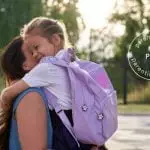
Our editors have independently chosen the products listed on this page. If you purchase something mentioned in this article, we may earn a small commission.
December 10, 2021 — 19:03 PM
What did you learn about climate change in grade school? I recall a fairly limited education: While the topic was mentioned in 12th-grade environmental science, it was absent in my health, history, and policy classes a decade ago.
Given all that scientists have confirmed about the rapidly evolving climate crisis in the years since—that it’s threatening our future and “unequivocally” caused by human activity—you’d think that, surely, it’s starting to make the syllabus in a more prominent way.
However, climate change is still not being discussed in the classroom—at least, not enough. According to 2019 NPR research, 84% of K–12 parents wanted their kids to learn about climate change, while only 42% of American teachers polled taught it. After spending years traveling the country reviewing textbooks and talking with teachers and students, journalist Katie Worth found many districts actively spreading climate misinformation and casting doubt on climate change in the name of politics.
This is incredibly dangerous, Worth writes in her new book Miseducation: How Climate Change Is Taught in America, because “if a significant portion of young people grow up to doubt the climate crisis is real, as their elders do, little is likely to change.”
On the other hand, recent research suggests that students who learn about climate change and how to combat it in the classroom are more likely to make more pro-environmental decisions and have lower carbon emissions as adults. You don’t need to look much beyond the School Strikes For Climate and Friday For Future protests to see that many of today’s young people want to be agents of change and are hungry for information on how to do so.
“I can say with confidence that young people are aching for skills and knowledge that will allow them to act effectively today,” Melati Wijsen, a teen activist from Bali who has been traveling the world to discuss climate issues since the age of 12, said in her recent TED Countdown talk. “Real change can start in the classroom, but the classroom has an increasingly distant relationship with reality,” she continues. “I think it is high time to ensure that what we learn in the classrooms reflects what is happening outside of them.”
In the name of climate education—and climate action—we asked young people what they’d like to learn more about in the classroom today so they can build a brighter tomorrow.
“The curriculum right now is only targeting the problem and not addressing solutions.”
Youth want to see more environmental justice-based content when it comes to becoming good climate citizens. Oftentimes front-line communities and the topic of environmental racism are avoided. We also want resources that go beyond individual actions. Examples include pitch-developing for campaigns and lobbying, social media training, organization practices for grassroots organizing. Ocean Heroes does an incredible job of providing an array of content to address the climate crisis from many angles.
In tangent with providing resources from multiple angles of the climate crisis, it would be valuable to hear from a range of experts each targeting a different sector (Policy, Science, Education, Grassroots Organizing, Youth). It is also important to highlight the voices from front-line communities and provide them a platform to speak out and share their stories.
The curriculum right now is only targeting the problem and not addressing solutions. When it is focusing on solutions, it is only individual-based solutions. However, the climate crisis needs to go beyond daily actions, to affect the systemic institutions that are upholding and worsening our current climate conditions.
—Hannah Testa, OH-Wake Magazine youth editor and creator of Hannah4Change
“We need role models and positive stories with an impact, real-life examples of how we can take action—and we need to see this from people our age.”
I think it is high time to ensure that what we learn in the classrooms reflects what is happening outside of them. And to ensure that every single student in every corner of the world has at least one hour a day of mandatory lessons about the climate crisis, the 17 SDGs, and about any sustainable innovations, about the realities of today’s world. From kindergarten through to graduation. And I mean mandatory…
We need role models and positive stories with an impact, real-life examples of how we can take action—and we need to see this from people our age. I wish I would have known refugee educator Mohamad Al Jounde from Syria, tree planter and entrepreneur Felix Finkbeiner from Germany, or gender equality activist Faye Simanjuntak from Indonesia when I was 12 years old. And I wish that I could have been able to jump on a call with them and share ideas and experiences.
—Melati Wijsen [as told to TED Countdown], activist, social entrepreneur, and founder of YOUTHTOPIA
“Climate change should be included in every topic. It affects every topic.”
sleep support+
Is great sleep in the stars for you tonight?*

We definitely need to be learning about climate change in day-to-day life. We need to be teaching students just how much it affects us every day. This means we include climate change in our current event discussions, in our science classes, in our math classes.
I’d also really appreciate learning about corporations’ decisions to support fossil fuel companies—not to mention the finances of fossil fuel companies themselves. Capitalism defines our lives in the U.S., but we learn so little about it, even after we’ve gotten our first jobs. Climate change is propelled by capitalism—they go hand in hand.
I’d also appreciate learning about animal habitats and depleting natural resources in depth. Right now, we still have ecosystems, but they’re struggling. I’d like to hear from environmental scientists—specifically those who do fieldwork in dying ecosystems—to learn their firsthand experience about what’s going on.
Being educated on the racial climate in the U.S. is also really important. There’s so much intersectionality within climate change, and it’s important to understand the systems that make climate change disproportionately impact people of color.
The schools that have access to clean, safe outdoor spaces should take advantage of that and use it to help students learn about the environment around them.
Finally, schools are missing teaching the urgency of climate change. Greta Thunberg herself said she was surprised when she learned about climate change and didn’t understand why it wasn’t on every headline. Our world is dying, people are dying, and we’re causing it. Climate change should be included in every topic. It affects every topic.
—Maia Frost, 11th grader in Boston, Mass., and a member of Boston Latin School Youth Climate Action Network
“The crucial thing that often gets lost in translation when it comes to climate education is why we should care.”
The crucial thing that often gets lost in translation when it comes to climate education is why we should care. Our generation has been pelted with the fact that we are inheriting this broken planet, so much so that the term “teenage burnout” has become our common state of being. There is a widespread apathy around climate justice; we know it’s bad but we don’t act on it.
The key to mobilizing entire generations to act for the environment is shifting the narrative so we stop compartmentalizing this current issue. We must connect ourselves with the issue and truly equate climate change to our own downfall. Otherwise, we will remain stagnant in our path for a cleaner world.
—Zoe Geller-Alford, 11th grader in San Diego, Calif., and a volunteer with San Diego 350, Period.Org, and her own organization called Kids, Actually
“If I could attend school all over again, I would hope to engage with an environmental curriculum that includes the founding origins of environmental justice…”
The mainstream narrative of environmental teachings on climate change has long scratched a surface-level take on the ethics of protecting humanity. An intersectional lens applied to environmental education can serve as a powerful way to root our ethics in community-informed solutions that center those most vulnerable to the climate crisis.
If I could attend school all over again, I would hope to engage with an environmental curriculum that includes the founding origins of environmental justice, the hidden and silenced sciences of Indigenous wisdom, and the social sciences and logistical applications of restorative justice.
I am beyond thrilled to be learning from students at Intersectional Environmentalist who have found curriculums and professors taking them down a more intersectional journey, and I’m looking forward to supporting a future where academia more widely takes on the responsibility of equipping youth with the knowledge needed to protect people and the planet.
—Diandra Marizet Esparza, executive director of Intersectional Environmentalist
Reset Your Gut
Sign up for our FREE doctor-approved gut health guide featuring shopping lists, recipes, and tips
You are now subscribed
Be on the lookout for a welcome email in your inbox!
https://www.mindbodygreen.com/articles/climate-curriculum-from-young-activists







